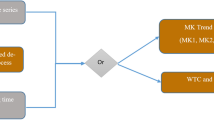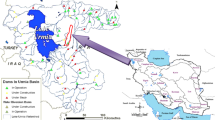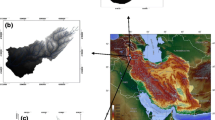Abstract
This work developed a novel framework for considering wavelet denoising in linear perturbation models (LPMs) and simple linear models (SLMs). Rainfall and runoff time series data were decomposed using wavelet transforms to acquire approximate and detailed rainfall and runoff signals, respectively, at various resolution levels. At each resolution level, threshold quantifications were performed by setting the values of a detailed signal below a certain threshold to zero. The denoised rainfall and runoff time series data were obtained from the approximation at the final resolution level and processed detailed signals using threshold quantification at all resolution levels of rainfall and runoff, respectively, by wavelet reconstruction. The data were then applied to the SLM and regarded as the smooth seasonal mean employed in the LPM. The noise, i.e., original time series value minus denoised time series value, was employed as the perturbation term in the LPM. Moreover, a linear relationship between input and output noise was assumed. The denoised runoff and estimated noise of runoff were summed to estimate overall runoff in the LPM. To verify the accuracy of the proposed method, daily rainfall–runoff data were analyzed for an upstream area of the Kee-Lung River. The analytical results demonstrate that wavelet denoising enhances rainfall–runoff modelling precision for the LPM.
Similar content being viewed by others
References
Alexander YS, Alan M, Sitakanta M (2009) Comparison of deterministic ensemble Kalman filters for assimilating hydrogeological data. Adv Water Resour 32:280–292
Chang SG, Yu B, Vetterli M (2000) Adaptive wavelet thresholding for image denoising and compression. IEEE Trans Image Process 9(9):1532–1546
Cui L, Chi D, Wu S (2009) Forecasting precipitation using gray topological with wavelet denoising. J Liaoning Tech Univ (Nat Sci) 28(5):853–856 (In Chinese)
Donoho DH (1995) Denoising by soft-thresholding. IEEE Trans Inf Theory 41(3):613–617
Hamid M, Soroosh S, Hoshin VG, Paul RH (2005) Dual state-parameter estimation of hydrological models using ensemble Kalman filter. Adv Water Resour 28:135–147
Kachroo RK, Liang GC (1992) River flow forecasting, Part 2. Algebraic development of linear modelling techniques. J Hydrol 133:17–40
Lim YH, Lye LM (2002) Denoising of streamflow series affected by tides using wavelet methods. Proceeding of Annual Conference of the Canadian Society for Civil Engineering. Montréal, Québec, Canada, pp 1–10.
Lin ZS, Zheng ZW (1999) Diagnosis technology of climate using wavelet. Meteorology, Beijing (In Chinese).
Liu GH, Qian JL, Wang JJ (2004) Study of flood forecast based on wavelet soft-threshold technology and ANN. J Hydroelectr Eng 23(4):5–10. (In Chinese)
Mallat SG (1989) A theory for multiresolution signal decomposition: the wavelet representation. IEEE Trans Pattern Anal Mach Intell 11(7):674–693
Martyn PC, David ER, Ross AW, Xiaogu Z, Richard PI, Andrew GS, Jochen S, Michael JU (2008) Hydrological data assimilation with the ensemble Kalman filter: Use of streamflow observations to update states in a distributed hydrological model. Adv Water Resour 31:1309–1324
Nash JE, Barsi BI (1983) A hybrid model for flow forecasting on large catchments. J Hydrol 65:125–137
Rao RM, Bopardikar AS (1998) Wavelet transforms, introduction to theory and applications. Addison-Wesley, USA
Reichle RH, Walker JP, Koster RD, Houser PR (2002) Extended versus ensemble Kalman filtering for land data assimilation. J Hydrometeorol 3:728–740
Shamsedlin AY, O’Connor KM (1996) A nearest neighbor linear perturbation model for river flow forecasting. J Hydrol 179:353–375
Wang XJ, Fei SM (2007) Application of wavelet analysis to hydrological runoff simulation. Water Resour Power 25(6):1–3 (In Chinese)
Wang WS, Ding J, Lee YQ (2005) Hydrological wavelet analysis. Chemical Industry, Beijing (In Chinese).
Wang HR, Ye LT, Liu CM, Yang C, Liu P (2007) Problems in wavelet analysis of hydrologic series and some suggestions on improvement. Prog Nat Sci 17(1):80–86
Wang WH, Hu SX, Li YQ (2010) Wavelet transform method for synthetic generation of daily streamflow. Water Resour Manag 25(1):41–57. doi:10.1007/s11269-010-9686-9
Wei YX, Wang LX (2005) Engineering hydrology. Water conservancy and electricity, Beijing (In Chinese)
Xiong LH, Guo SL, O’Connor KM (2006) Smoothing the seasonal means of rainfall and runoff in the linear perturbation model (LPM) using the kernel estimator. J Hydrol 324:266–282
Author information
Authors and Affiliations
Corresponding author
Rights and permissions
About this article
Cite this article
Chou, Cm. A Threshold Based Wavelet Denoising Method for Hydrological Data Modelling. Water Resour Manage 25, 1809–1830 (2011). https://doi.org/10.1007/s11269-011-9776-3
Received:
Accepted:
Published:
Issue Date:
DOI: https://doi.org/10.1007/s11269-011-9776-3




